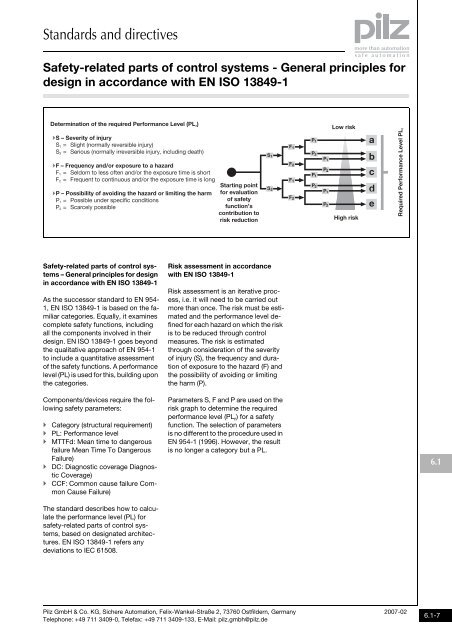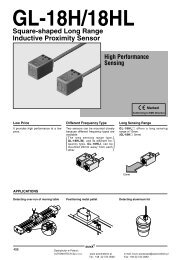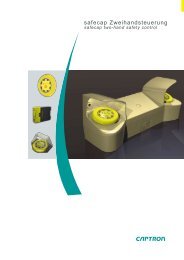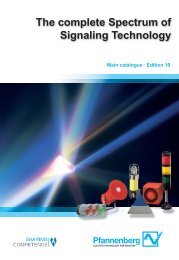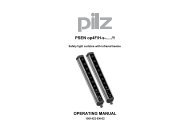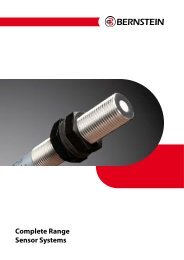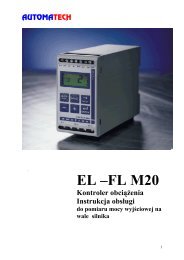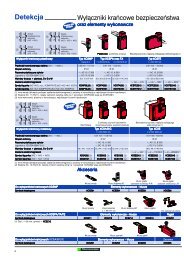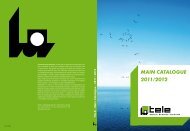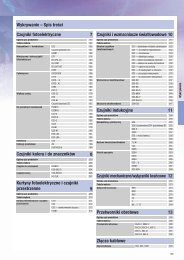Expansion modules - Automatech
Expansion modules - Automatech
Expansion modules - Automatech
You also want an ePaper? Increase the reach of your titles
YUMPU automatically turns print PDFs into web optimized ePapers that Google loves.
Standards and directives<br />
Safety-related parts of control systems - General principles for<br />
design in accordance with EN ISO 13849-1<br />
designinacordancewithENISO13849-16.1207-02Standards andirectivesSafety-relatedparts of control systems<br />
General principles for<br />
Determination of the required Performance Level (PL r )<br />
S – Severity of injury<br />
S 1 = Slight (normally reversible injury)<br />
S 2 = Serious (normally irreversible injury, including death)<br />
F – Frequency and/or exposure to a hazard<br />
F 1 = Seldom to less often and/or the exposure time is short<br />
F 2 = Frequent to continuous and/or the exposure time is long<br />
P – Possibility of avoiding the hazard or limiting the harm<br />
P 1 = Possible under specific conditions<br />
P 2 = Scarcely possible<br />
Starting point<br />
for evaluation<br />
of safety<br />
function’s<br />
contribution to<br />
risk reduction<br />
Low risk<br />
High risk<br />
Required Performance Level PL r<br />
Safety-related parts of control systems<br />
– General principles for design<br />
in accordance with EN ISO 13849-1<br />
As the successor standard to EN 954-<br />
1, EN ISO 13849-1 is based on the familiar<br />
categories. Equally, it examines<br />
complete safety functions, including<br />
all the components involved in their<br />
design. EN ISO 13849-1 goes beyond<br />
the qualitative approach of EN 954-1<br />
to include a quantitative assessment<br />
of the safety functions. A performance<br />
level (PL) is used for this, building upon<br />
the categories.<br />
Components/devices require the following<br />
safety parameters:<br />
Category (structural requirement)<br />
PL: Performance level<br />
MTTFd: Mean time to dangerous<br />
failure Mean Time To Dangerous<br />
Failure)<br />
DC: Diagnostic coverage Diagnostic<br />
Coverage)<br />
CCF: Common cause failure Common<br />
Cause Failure)<br />
The standard describes how to calculate<br />
the performance level (PL) for<br />
safety-related parts of control systems,<br />
based on designated architectures.<br />
EN ISO 13849-1 refers any<br />
deviations to IEC 61508.<br />
Risk assessment in accordance<br />
with EN ISO 13849-1<br />
Risk assessment is an iterative process,<br />
i.e. it will need to be carried out<br />
more than once. The risk must be estimated<br />
and the performance level defined<br />
for each hazard on which the risk<br />
is to be reduced through control<br />
measures. The risk is estimated<br />
through consideration of the severity<br />
of injury (S), the frequency and duration<br />
of exposure to the hazard (F) and<br />
the possibility of avoiding or limiting<br />
the harm (P).<br />
Parameters S, F and P are used on the<br />
risk graph to determine the required<br />
performance level (PL r ) for a safety<br />
function. The selection of parameters<br />
is no different to the procedure used in<br />
EN 954-1 (1996). However, the result<br />
is no longer a category but a PL.<br />
6.1<br />
Pilz GmbH & Co. KG, Sichere Automation, Felix-Wankel-Straße 2, 73760 Ostfildern, Germany<br />
Telephone: +49 711 3409-0, Telefax: +49 711 3409-133, E-Mail: pilz.gmbh@pilz.de<br />
2007-02<br />
6.1-7


